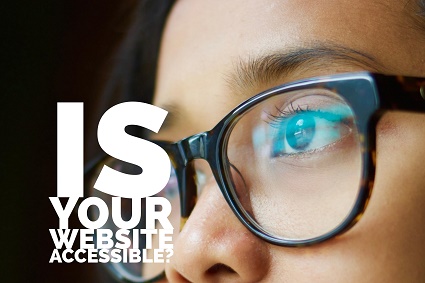Your cart is currently empty!

Americans with Disabilites Act and Your Website
Does your website meet the requirements of the Americans with Disabilities Act (ADA)?
A client recently shared with us an email she had received:
“Scores of companies, financial institutions, and other entities across the country have been targeted by plaintiffs’ attorneys for purported violations of the Americans with Disabilities Act (ADA) because their websites have “access barriers” for individuals with visual impairments. From demand letters to lawsuits, these plaintiffs’ attorneys are crawling the web for unsuspecting businesses with websites that fail to meet the U.S. Department of Justice-endorsed standards, under the theory that these “places of public accommodation” are violating the ADA.”
This is an example of fear-based marketing, but that doesn’t mean they don’t have a point.
Back in 2010, the Department of Justice issued an Advanced Notice of Proposed Rulemaking. The notice stated that company websites are “places of public accommodation,” and therefore subject to the Americans with Disabilities Act. The DOJ confirmed this position in a letter in 2018.
Just as your office must have an entrance that’s accessible to people with limited mobility, your website has to be accessible to someone with limited vision. And that’s not all. The Americans with Disabilities Act refers to all kinds of limitations; some of these limitations affect use of your website in ways that might not be obvious to you.
Americans with Disabilities Act requirements
According to the National Law Review, the application of the ADA to websites continues to be controversial. It is being tested in the courts, and that is always a lengthy and complicated business. While you’re waiting for that to shake out, you should go ahead and follow the ADA Title II checklist or the w3.org accessibility guidelines. These efforts make sure that your website is accessible and should cover you if you end up as part of the courtroom testing.
Here’s a quick overview of the Accessibility Guidelines:
- Content must be available to everyone. That means that there should always be text, since pictures and videos may not be visible to everyone. Assistive devices can read text, but but not images.
- There should be alternatives to time-based media such as video and audio. This might include sign language, text captioning, or audio alternatives.
- Using the site shouldn’t depend on sensory information. That is, choosing the right color or shape shouldn’t be the only way to navigate through a site. Following a path through the site shouldn’t require people to be able to see a pattern — there should be text cues, too.
- The site architecture should be clear and predictable. Clicking on or hovering over a link shouldn’t cause surprising things to happen.
- The site should be highly readable. Things like light text on dark ground, low contrast, highly decorated text, etc. make a website harder to read.
- Avoid including elements on your website that are known to cause seizures in some people.
- It should be possible to access and operate the website with a keyboard (not just a mouse or touch screen) and to use assistive readers and similar devices to read all text.
- The website design should help prevent errors. For example, if there is a form to fill out, it should let users know if they have made an error (say, using a different format for a phone number than the one required) rather than just failing to respond.
Testing your website
These are reasonable guidelines, but you might not initially think of them. A young web designer with perfect vision may not notice readability issues. A highly visual processor may find color-based structures easier and more logical than other types and not consider how it will work for people using assistive readers.
Fortunately, you can check and see if you have issues.
Use the WAVE accessibility testing tool to identify issues at your website. It will show you all the possible concerns.

Note that some of the issues WAVE identifies may not be things that you can or should change.
For example, it will identify the fact that you are using a PDF file. While PDFs are not universally accessible, there are times when they are the best option. A primary historical document, for example, may exist only as a PDF. In this kind of case, we usually provide a transcript of the most important parts of the text on the web page, while providing the PDF as a reference.
You may also need to use PDF files for patient forms. We often provide an interactive alternative, but some of your patients may be uncomfortable with an interactive online form, and need the option of printing the form and filling it out by hand. This can be particularly important for older populations or those with limited English. The testing tool is not intended to limit accessibility for some groups by providing it for other groups.
It provides excellent guidance for making sure your website is accessible. Then you can work with your web team to decide the best way to approach the issues.
Are you likely to be sued? It’s more likely than it used to be, but is still not very likely. But making your website accessible should be on your to-do list in any case. It’s the right thing to do.
by
Tags:

Leave a Reply